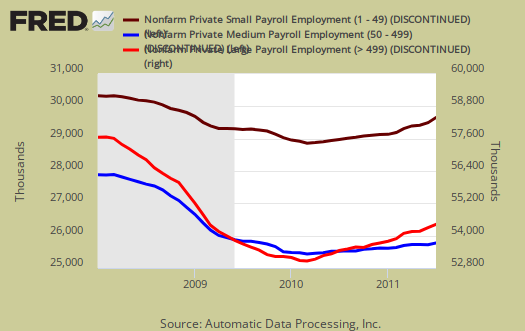ADP, a private organization, released their private payrolls jobs report. This month ADP is reporting a gain of 114,000 private sector jobs in July 2011. June was revised down to 145,000, in stark contrast to the BLS reported 57,000 private sector jobs. Below are the reported private sector jobs from ADP. This report does not include government, or public jobs.

ADP is reporting the service sector created 121,000 jobs while the goods sector lost 7,000 jobs. The ADP tab on manufacturing is -1,000 jobs for the month. ADP's professional business services jobs tally increased by 55,000 and health care reported increases are 48,000. This report, if it matches tomorrow's official unemployment report, is still weak job growth. Also,the recent initial unemployment claims reports are past 400,000 and anything above 400,000 in initial claims does not indicate job creation.
Construction dropped another 11,000 jobs and the ADP notes 2,135,000 construction jobs are reported gone since the 1st of January 2007.
Considering the great bank bail outs and resulting profits, ADP's financial sector numbers are astounding. 687,000 jobs have been lost since January 2007 with another 1,000 gone for July 2011. Were these jobs offshore outsourced?
We take the ADP report with a grain of salt, especially on a monthly basis. Why? While ADP acknowledges hiring is slowing, there is a strong mismatch against the BLS jobs report. To date, the number of private nonfarm payroll jobs ADP reports versus what the BLS reports and on a month-to-month and even cumulative basis do not match. This monthly error is often large, especially when looking at small job growth overall (< 400,000 jobs per month) on a month to month basis.
Below is the cumulative difference between what the ADP reports as the private nonfarm payroll jobs vs. the BLS (ADP minus BLS). This line shows the divergence, over time in number of nonfarm private payroll jobs reported between the two reports. This post will updated to include the July ADP & BLS numbers when released on Friday.

While ADP notes a simple correlation of 0.95, well, a 5% error between monthly reported jobs numbers is an average, and we can see on some months the differences are quite large and around 2008, the difference started to hit about 900,000 jobs.
ADP does use the same seasonal adjustment as the BLS, but their other methodology and even sampling size are different, is proprietary and also seems to change from month to month. Generally the ADP claims their sample size is at least twice as large as the BLS current employment statistics survey. The ADP does not incorporate a birth/death model, although they do categorize jobs by the NAICS codes, the same as the BLS.
Bottom line, the official report, upon which other metrics are based, is the BLS. Additionally, since the BLS is our government, we get to find out exactly what methods and models they use, unlike ADP.
All of this said, the reality is the The United States currently needs about 12 million jobs to get back to pre-recession levels, taking into account population growth and the labor participation rate back in December 2007. Anyone jumping all over themselves over < 200,000 jobs added in one month, at minimum, isn't taking population growth into account and is experiencing fantastical wishes instead of what's true. They are drowning in error margin pipe dreams.
There is one thing to note that is worth looking at, especially due to it's relativity within the same report (and methods). ADP reports on large vs. medium vs. small businesses and their job creation per business size. In July:
Employment on small payrolls (up to 49 workers) rose 58,000 in July, while employment on medium payrolls (50 to 499 workers) rose 47,000. Employment on large payrolls (500 or more workers) rose a smaller 9,000.
Below is the graph of ADP private sector job creation breakdown of large businesses (bright red), median business (blue) and small business (dark red). For large business jobs, the scale is on the right of the graph. Medium and Small businesses scale is on the left.
This is the same result every month. Large business, who lobby Congress for their bad trade deals and labor arbitrage are non-existent for hiring Americans. Notice how large businesses have been declining and the pattern starts just about the time offshore outsourcing and the China PNTR came into effect. Small businesses, on the other hand, have increased employment. May I suggest that small businesses are not international, they are not signing offshore outsourcing contracts and moving jobs to India and China. Multinationals, on the other hand, the below decade trend line clearly shows these so called U.S. corporations have abandoned the U.S. worker, on whole. Earlier, the BEA reported statistics validating the ADP job creation trends by business size.

Here is the June 2011 ADP private sector jobs report overview.

Recent comments